Invasive Species
Ahh, it's spring again!
Time to get out and clear the property of last’s years leaves and fallen branches, give the lawn mower a short spin, take the garden furniture out of the shed, weed the flower beds and possibly plant some new perennials ...
But wait! Do you know what you are planting? Got some nice flowers from the garden center? Well, you might better check if those plants you bought are not invasive. Once planted, they could take on a life of their own, spread from your flower bed into your lawn, your driveway and finally into the lake.

And believe me, getting rid of unwanted vegetation is many times more work than planting it. And not only is it hard work, the damage you might have done to your environment by selecting the wrong flowers can be time-consuming to repair and ... very costly.
One of those beautiful flowers you might have chosen for your backyard is the Yellow flag iris. However, Yellow flag iris invades ditches, wetlands, streams, lake shorelines, and shallow ponds.
This plant reproduces through seed dispersal and horizontal roots. When pieces of the roots break off, they form new plants. The seeds float on the water in spring and fall, causing them to spread quickly. Several hundreds of plants may be connected underwater due to the extensive root system, which creates a thick mat that damages wildlife habitat, reduces water flow, and crowds out native vegetation.
In May 2019, a group of Bridge Lake volunteers and members of the Invasive Species Council of BC visited two sites on our lake which had infestations of Yellow flag iris. Under the direction of Catherine Tarasoff (of Agrowest Canada), who has been studying Yellow flag iris for the past several years, benthic barriers (a type of heavy duty PVC vinyl) were spread across the infested area after the plants had been cut back. The barriers were spread over the whole area and secured with spikes and rocks to cover both the land are and the water where the plants were present.

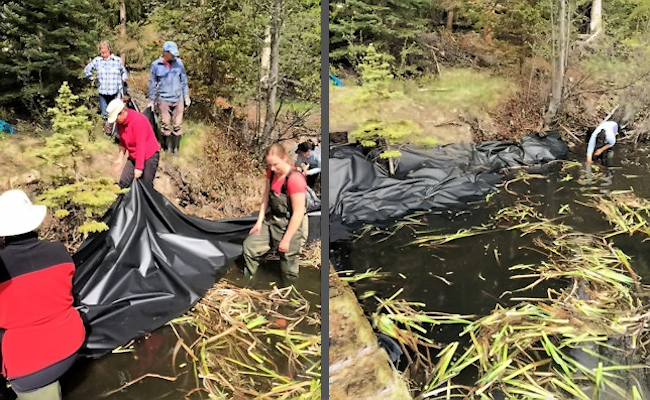
The barriers will be left in place for many months, and the areas on land may need to be left in place for over a year to make sure all the roots of the plants have died. Both areas will be monitored to see if the treatment has been successful.
Here ares some other species you better stay away from:
(Note: The following list contains only those plants and flowers that can negatively impact our lakes and rivers. However, there are many more species that are a danger to our whole ecosystem. A comprehensive list of those can be found here. Unfortunately, although being known to be “invasive”, many of these flowers and plants are still freely available at supermarkets and garden centers throughout BC)
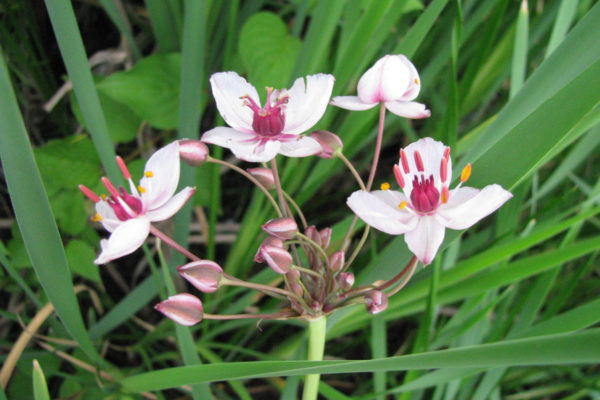
Flowering rush is an aquatic perennial with green, grass-like foliage and pink almond-scented flowers. It can be difficult to identify as it resembles several native species, but quickly crowds out other plants. It is considered a noxious weed throughout the province. It impedes the use of shallow waters for recreation, irrigation & industrial activities, and alters natural ecosystems.
Flowering rush typically grows in shallow waters but can survive in water as deep as 6m. Stems range from 1-1.5 m tall and sprout from the crown of the plant. Flowers in pink umbrella shaped clusters on delicate, 5-10 cm long flower stalks. Two key identification features are the distinct triangular cross-section of the leaves and roots that are thick with bulbous nodes.
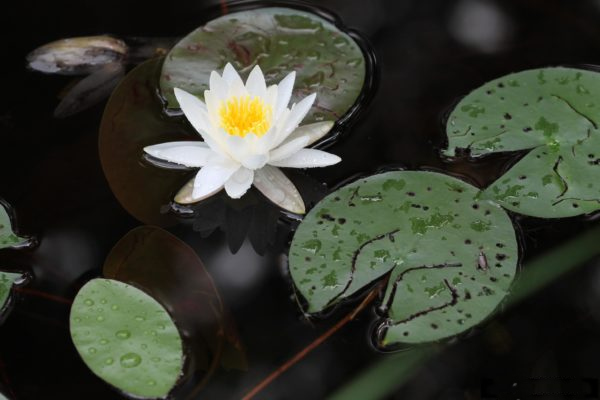
This popular, fragrant aquatic perennial is still sold in garden and pond centers throughout the province and prized by gardeners for its classic “lily pad” look and large white or pink flowers. However, it has escaped from cultivation and established in some waterways in BC, its thick roots choking out native aquatic species, causing a risk to swimmers, impeding recreation, and restricting the movement of animals.
It has the potential to spread and severely impact these sensitive aquatic ecosystems. Additionally, this species is extremely hardy and can overwinter in many regions of BC - do not be tempted to use this plant in your water gardens, no matter where you live in BC.
Round, glossy green leaves that float on the water’s surface. Leaves are connected to the underwater rhizomes by long, slender stems. Flowers are very showy, in white or pink, and fragrant.
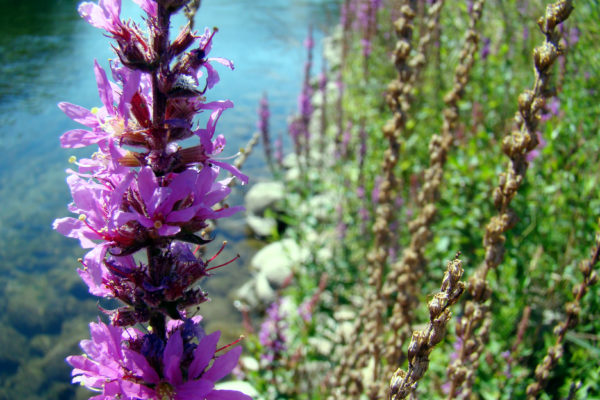
Purple loosestrife is a pretty perennial plant that spreads rapidly by seed and root fragments. The tiny seeds are dispersed by wind, mud, moving water, wildlife and humans. A mature plant can produce up to 2.5 million seeds that can survive in the soil for up to 20 years. Purple loosestrife grows in wetlands and aquatic habitats, as well in wet pastures and roadside ditches and is quite easily recognized by its flowers.
Purple loosestrife has a shrub-like appearance, stiff, four-sided stems ending in dense spikes of showy pinkish-purple flowers. It has narrow, stalkless leaves. Plants can grow up to 3 meters in height. Purple loosestrife is often confused with the native plant fireweed.
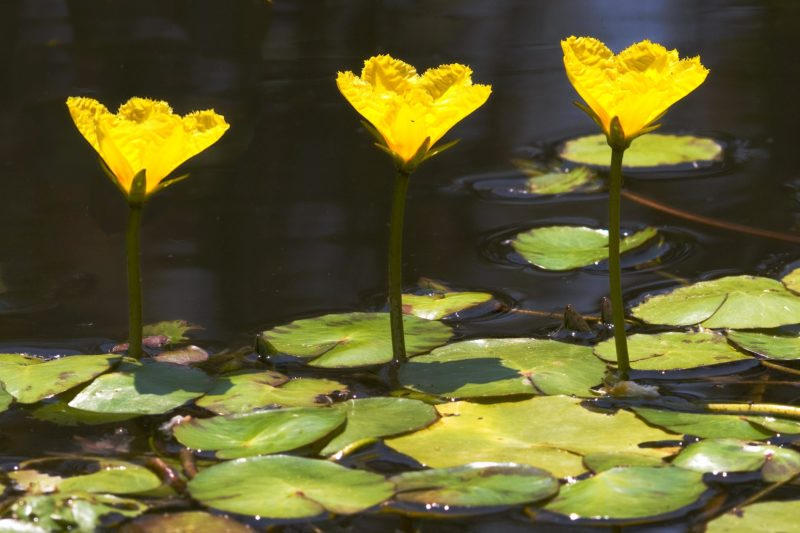
Native to Eurasia, Yellow floating heart is an aquatic species that resembles water lily. It spreads both by seed and vegetative making this species extremely difficult control. It forms dense mats that impede water flow and disturbs sensitive aquatic habitats. It was initially used as an ornamental pond plant but has escaped cultivation and has the potential to cause major damage in BC – if you see this species, be sure to report it immediately. Yellow floating heart prefers depths of up to 4m and slow-moving water.
Yellow floating heart has round, floating leaves 3-15 cm in diameter that sit on the surface of the water, typically found growing in dense mats. When flowering, the single yellow flowers appear on stalks above the leaf. The fruit is a flattened, oval capsule that turns from green to brown as it matures and ripens.
In addition to plants, many aquatic invasive species (fish, amphibians, mussels, crayfish, etc.) have been detected in almost all regions of the province. Invasive freshwater fish species in particular have expanded in both number and geographic area.
In order to prevent the introduction and spread of aquatic invasive species it is necessary to
- Clean plants, animals and mud from your boat and gear
- Drain all water from your boat and gear onto land
- Dry all parts of your boat and gear completely
This will only take a few minutes of your time, but it will help to keep our lakes and rivers clean and for future generations of anglers and boaters to enjoy.
Disclaimer: Some of the text and pictures on this page were assembled from the Invasive Species Council of BC website.